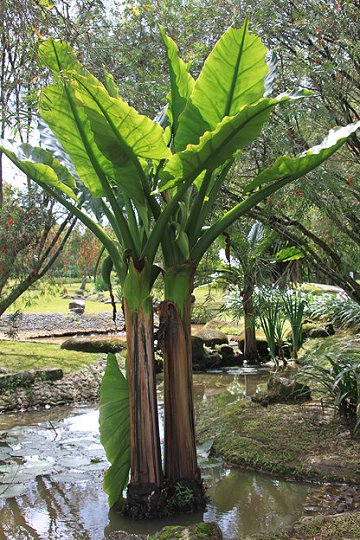
|
|
Water Banana
(Typhonodorum lindleyanum)
|
Water Banana - Typhonodorum
lindleyanum
Typhonodorum is a monotypic genus of flowering plants in the family Araceae. The single species making up this genus is Typhonodorum
lindleyanum. The genus is native to Madagascar, the Comores, Zanzibar, and
Mauritius. This genus is believed to be closely related to Peltandra even though Peltandra is only found in North America and there don't appear to exist closely related genera in the African
mainland. There isn't fossil evidence to link the two genera so it has been proposed that there once was a genus in Africa from which the two genera had
originated. The African mainland genus spread to North America and to Madagascar 50 million years ago before it broke
off. Then the African genus became extinct and the North American and Madagascan genera
remained.
Typhonodorum lindleyanum or Water Banana is the only member of the genus
Typhonodorum.
It has a truly striking appearance: the looks of a banana plant with large leaves like a
taro.
Typhonodorum lindleyanum
found near the banks of muddy streams or in marshes. Usually found in pure stands in fresh water swamps near the
sea.
Typhonodorum lindleyanum is a perennial plant producing
a stout, banana-like, pseudostem up to 30cm in diameter topped with a rosette of
leaves from a short horizontal fleshy rhizome.
The plant is usually 1.5 to 2.5 metres tall, but can be up to 4 metres.
The pseudostem is formed by brown, dead leaf sheaths. The projecting portion of the petiole is 30-100 cm
long, green and succulent, with numerous leaves. The leaf is subtriangular to
arrow-shaped, light green, 70-140 cm long and 55-85 cm wide. The leaf discs of young plants are
narrower. The midrib is quite wide: 1-1.5 cm at the base.
The petiole is erect, 40-50 cm long and 3 cm in diameter. After flowering, it hangs
down. The spathe is 45-80 cm long, narrowed between the male and female flowers, rolled up to form a tube towards the
base. The spadix is yellow, 35-55 cm long and 3 cm in diameter. Blooms throughout the
year.
The infrutescence is 17 cm long and 12 cm in diameter, the spathe becomes green, then putrid at maturity of the
fruit. The fruit is a spherical to ovoid berry, 4 cm in diameter, bright yellow, with one and sometimes two
seeds. The seeds are flattened, 3?3 cm and 1.5 cm thick, greenish brown.
The plant is harvested from the wild and used
locally, providing a food of very dubious value plus medicines and a good quality
fibre. The plant is sometimes grown as an ornamental.
In the tropics, it can grow in the garden throughout the
year. In temperate regions you can treat it as an orangery plant: indoors in winter and outdoors in
summer. It can also be grown as a houseplant or in a heated greenhouse.
In the tropics, this is an invasive species.
Etymology: Typhonodorum: from the Greek typhos
(typhoon, hurricane) and doron (gift) Lindleyanum: in honor of John Lindley, renowned English botanist (1817-1898).
Common names: Water Banana, mangaoka, mangibo, viha, via, mgombakofi, mtongonya
fruits and rhizome are poisonous but eaten locally after prolonged boiling
Rhizome- must be thoroughly cooked. An edible starch is obtained from this rhizome by drying the grated base of the plant over a slow fire. In spite of the action of the fire, however, this starch causes an itching in the mouth and even in the oesophagus[644]. It is more common, when rendering the roots of plants in this family edible, to bake them for some time at high temperatures, often pounding them into a powder and then baking them again. This is a more effective way of destroying the toxins, though even then it is not unheard of for people to experience itching of the mouth.
The tuber can be peeled then cut into small slices which are boiled and washed several times in order to remove some of the toxic matter. Coconut milk is then added and the whole is eaten[398]. Alternatively, the slices can be soaked in water for two days and then dried in the sun. The dried slices are pounded into a flour which is cooked into ugali. The root is mainly viewed as a famine food, eaten when there is nothing better available.
Fruit cooked. It needs to be boiled for a long time[46]. The same comments apply to the fruit as they do to the rhizome.
The starch from the rhizome is considered an excellent remedy against the bites of venomous
animals.
Source:
https://en.wikipedia.org/wiki/Typhonodorum
http://tropical.theferns.info/viewtropical.php?id=Typhonodorum+lindleyanum
https://myjunglegarden.com/2015/11/typhonodorum-lindleyanum/#.WVOkddGQwdU
